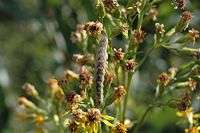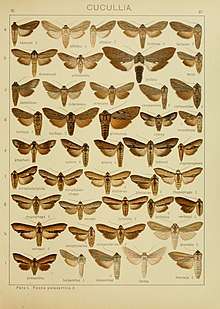Cucullia gnaphalii
The Cudweed (Cucullia gnaphalii) is a moth of the family Noctuidae. It is found from most of Europe (except Ireland and most of the Balkan Peninsula)[1] to Turkey, Transcaucasia, Mongolia and Sayan.[2]

| Cucullia gnaphalii | |
|---|---|
 | |
| Cucullia gnaphalii 27e | |
| Scientific classification | |
| Kingdom: | Animalia |
| Phylum: | Arthropoda |
| Class: | Insecta |
| Order: | Lepidoptera |
| Superfamily: | Noctuoidea |
| Family: | Noctuidae |
| Genus: | Cucullia |
| Species: | C. gnaphalii |
| Binomial name | |
| Cucullia gnaphalii (Hübner, 1813) | |
| Synonyms | |
| |
Technical description and variation
C. gnaphalii Hbn. (27 e). Like xeranthemi, from which it is distinguished by the more rounded orbicular, not 8-shaped; by the absence of a black shade before outer line in submedian fold, while the black line beyond it is thickened and more conspicuous; the outer line being bent at right angles on the fold, its lower half vertical; above vein 4 a black streak from the reniform stigma, interrupted in the middle; a black streak along middle of inner margin; hindwing brownish, the basal half paler, but not nearly so pale as in xeranthemi. Larva deep green; dorsal stripe broad, red-brown; spiracles yellow on an interrupted redbrown streak; head green.[3] The wingspan is 38–46 mm.
Biology
Adults are on wing from May to July.[4] There is one generation per year.
The larvae feed on the flowers and leaves of Solidago virgaurea, Solidago canadensis, Artemisia absinthium and Artemisia vulgaris hiding by day under the leaves close to the ground. The species overwinters in the pupal stage, in a tough earthen cocoon usually among surface debris or sometimes underground.
References
- Fauna Europaea
- Cucullia at funet
- Warren. W. in Seitz, A. Ed., 1914 Die Großschmetterlinge der Erde, Verlag Alfred Kernen, Stuttgart Band 3: Abt. 1, Die Großschmetterlinge des palaearktischen Faunengebietes, Die palaearktischen eulenartigen Nachtfalter, 1914

- UKmoths